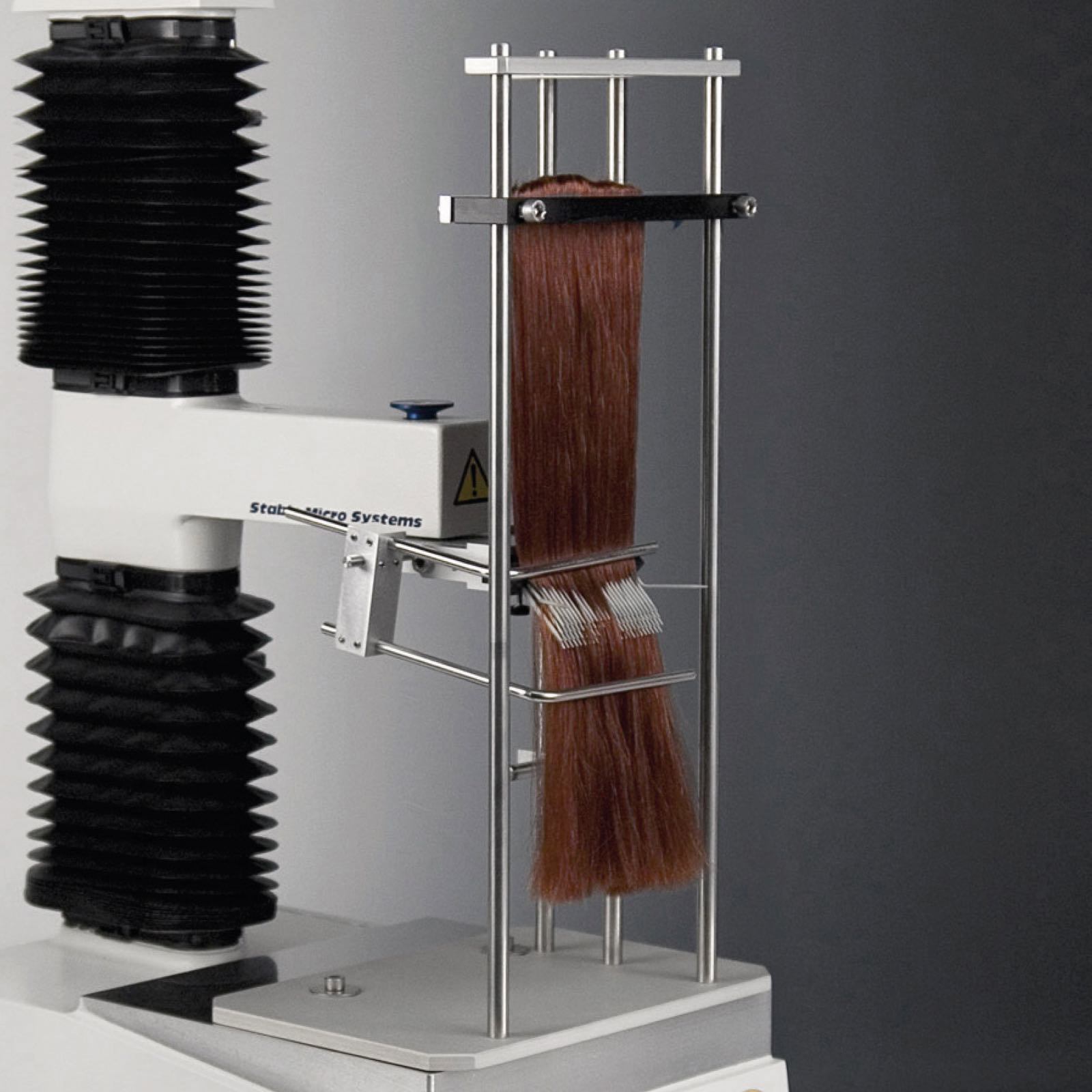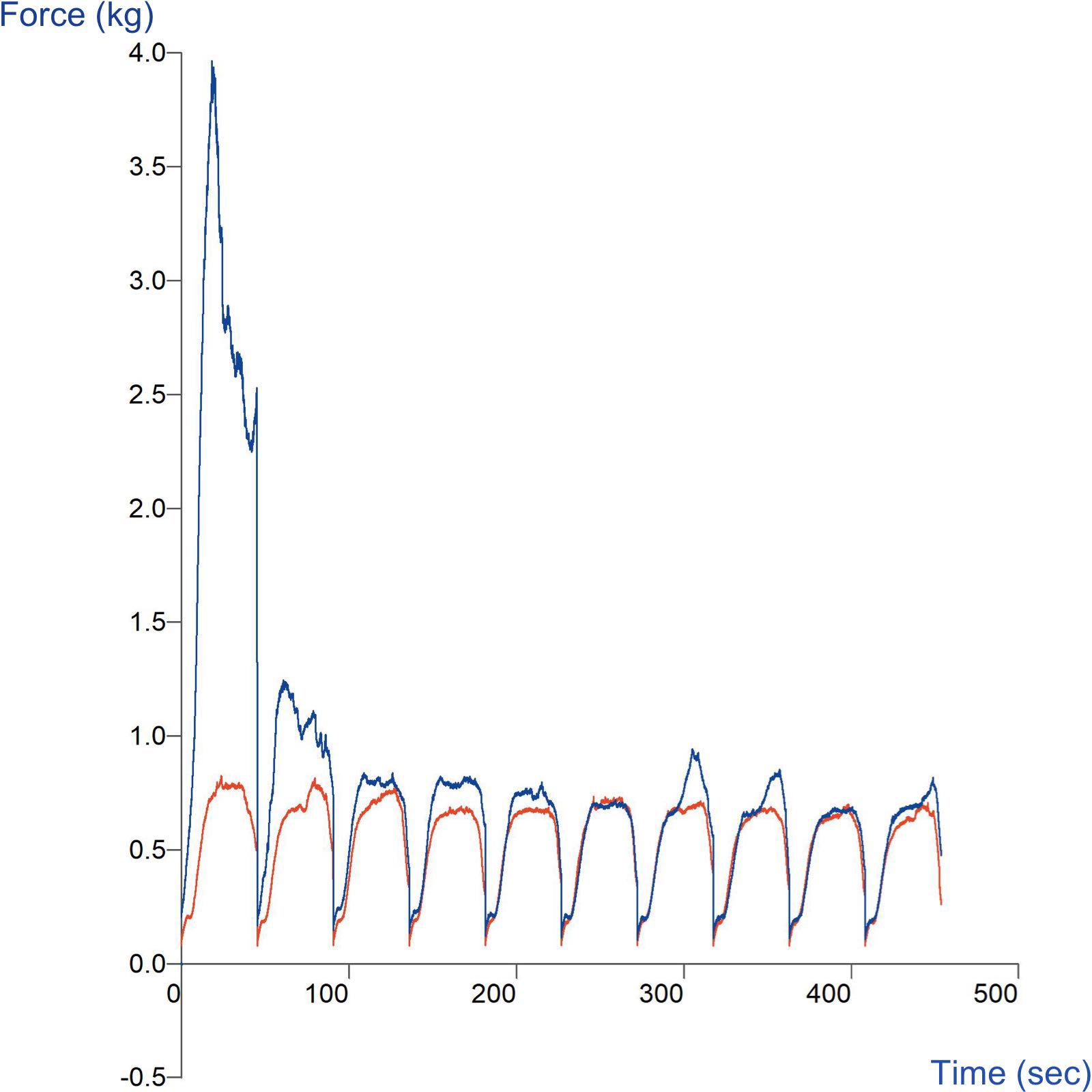How to measure combability

Combability testing: definition and importance
Combability refers to the ease with which hair or other fibres can be combed. Hair health and manageability are crucial for personal appearance, as the condition of the hair cuticle affects how it feels to the touch and how easily it can be combed. Damage to the hair surface, such as from UV exposure, increases the force required to comb the hair, making combability measurements an important tool for assessing hair damage and product effectiveness.
Hair care products like conditioners and shampoos are formulated to reduce combing force, enhance smoothness, and improve manageability by incorporating ingredients such as silicones, cationic surfactants, and polymers. Combability testing with a Texture Analyser helps quantify these benefits by measuring the force required to comb treated versus untreated hair swatches.
Further example applications of comb ability testing
Combability measurements using a Texture Analyser are valuable in the cosmetics and personal care industries to evaluate the ease of combing and manageability of hair, and other fibrous materials. Here are some key applications:
- Hair care product testing: Evaluating the effectiveness of conditioners, detanglers, and hair sprays in improving hair combability by measuring the force required to comb through a hair tress treated with a conditioner to assess its detangling properties.
- Hairbrush and comb design optimisation: Testing various brush or comb designs to identify the most user-friendly options for easier combing. For example, comparing the combability of different hairbrushes by measuring the force required to pass them through a standardised hair sample.
- Evaluation of wig and hairpiece materials: Assessing the combability of synthetic and human hair used in wigs and hairpieces.
- Personal care product development: Testing the effectiveness of grooming products, such as beard oils or hair serums, in improving combability by measuring the force needed to comb through a beard treated with beard oil to evaluate its detangling and smoothing properties.
In these examples, a Texture Analyser simulates the combing process by applying controlled forces/distances, helping manufacturers optimise products and materials to improve combability, manageability, and user experience.
Typical probe/attachment used for measurement
In a typical combing test, a comb is drawn through the hair at a constant speed and the Texture Analyser records the force required to move the comb through the hair tress in either a single test or a continuous cyclic motion for a chosen number of combing cycles.
How to interpret the Texture Analyser graph
 Typical curve indicating key analysis points of combability test
Typical curve indicating key analysis points of combability test
When measuring combability in a multiple cyclic test, the force vs distance/time graph typically shows multiple force increases, plateaus and drops according to the behaviour of the hair and the effect of the treatment upon it. The shape of each cycle can provide insights into hair condition and treatment effectiveness e.g. smoother curves indicate more uniform resistance and better-conditioned hair. Good combability will result in a smooth, continuous force curve with few or no peaks, indicating that the material is easily combed without significant resistance. The presence of tangles or knots will cause sharp spikes in the force curve, showing where the comb encounters significant resistance. The more tangles, the higher and more frequent these peaks will be. From the graph you can observe/obtain the following:
- Combing Force
- Resistance to Combing
- Work of Combing
A full explanation of this curve and its analysis can be accessed within Exponent Connect software. Existing Exponent users can upgrade to Exponent Connect specification.
Below is a video example of how we can help you understand curve analysis for an example property.
Further analysis
- Wet vs. dry combing: Tests can be performed on both wet and dry hair to assess product effectiveness in different conditions.
- Comparison to baseline: Results are typically compared to untreated hair or hair treated with a control product.
- Smooth vs irregular force curve: In materials with high combability, the graph will show a smooth, low curve, indicating that the fibres offer little resistance as the probe moves through. In materials with low combability, you may see jagged peaks where the probe encounters resistance from tangled or dense fibers. The size and frequency of these peaks can provide insight into how difficult the material is to comb.
- Multiple passes: Some tests involve multiple combing cycles to assess how combability changes with repeated combing.
Key factors affecting combability measurement
- Temperature: The temperature of the hair and testing environment can influence the hair's mechanical properties.
- Humidity: Ambient humidity levels can affect the moisture content of hair, potentially altering its combability.
- Hair type (e.g., straight, curly, chemically treated): can influence baseline combability and response to treatments.
- Hair swatch preparation: Consistency in hair swatch size, weight, and preparation method is crucial for accurate measurements.
- Detangling and tangling: Controlled detangling and re-tangling of hair swatches before testing ensures reproducible results.
- Combing speed: The rate at which the comb moves through the hair can influence the measured combability.
- Wet vs. dry combability: Testing can be performed on either wet or dry hair, each providing different insights into hair condition and product efficacy.
- Number of combing cycles: The number of times the hair is combed during the test can affect the results.
- Comb design: The type, size, and spacing of comb teeth can impact combability measurements.
- Comb material: The material of the comb can affect its interaction with the hair fibres.
- Combing method (e.g., single comb vs. double comb): can affect the results and should be consistent across tests.
Optimising combability measurement and analysis: The Stable Micro Systems advantage
The Stable Micro Systems Texture Analyser excels in optimising combability measurements through its specialised Hair Combing Rig and advanced analytical capabilities. This dedicated setup precisely measures the force required to comb through hair samples, offering versatile testing for both wet and dry conditions. With customisable parameters and the ability to perform multiple combing cycles, it accurately simulates real-world usage.
The Exponent Connect software captures detailed force-distance-time profiles, enabling comprehensive analysis of combing characteristics. It is highly sensitive to hair surface changes, making it invaluable for evaluating shampoos, conditioners, and hair treatments.
This combination of specialised equipment, precise measurement, and in-depth analysis makes the Texture Analyser the optimal choice for researchers and manufacturers in the hair care industry seeking to refine product performance and assess hair condition.
Dedicated setup for accurate quantification of hair properties.
Comprehensive analysis of combability graph features with high data acquisition rate.
Wet and dry combability assessment.
Repeated stroke settings for multiple cycle test of consumer-like action.
If you need help with your combability measurement, we offer unrivalled support.
We can walk you through the steps to successful testing and analysis of combability forces.



